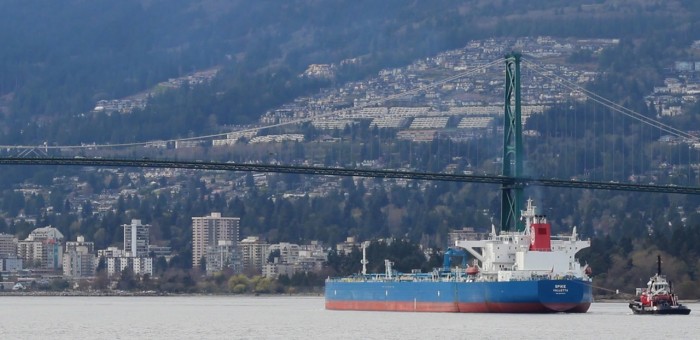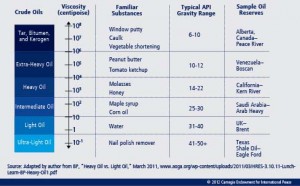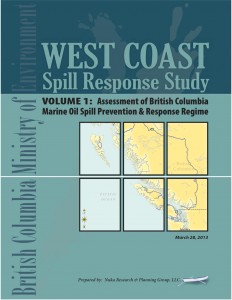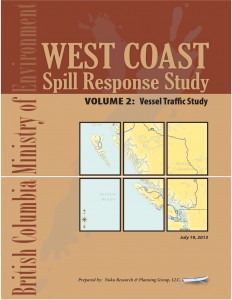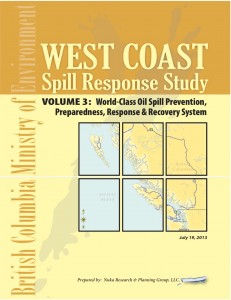Heavy Oil Pipelines: Background
With the development of the Alberta oil sands, the Federal government and stakeholders in the oil sands industry have been looking for new heavy oil export opportunities. One path that is under consideration is to transport heavy oil across British Columbia for shipment by tanker to international refineries.
There are two major heavy oil pipeline proposals that are being considered in British Columbia. The first is the Northern Gateway Pipeline, proposed by Enbridge. This pipeline would run 1,177km from Northern Alberta to the port of Kitimat, B.C. and would transport up to 525,000 barrels of heavy oil per day. The second proposal is an expansion of Kinder Morgan’s existing Trans Mountain Pipeline, which runs 1,150 km from Strathcona Country, AB, to Burnaby, BC. The expansion would increase the carrying capacity of the pipeline from 300,000 barrels per day, to 890,000 barrels per day.
One of the key concerns with these pipeline projects is that the type of oil that will be transported is not traditional crude oil. Instead, the heavy oil that would be transported is called “diluted bitumen” or “dilbit”. Bitumen by itself is very viscous (like window putty, caulk or vegetable shortening) and so does not flow through pipes. As such, it is mixed with condensates (other very light hydrocarbons) with an API (American Petroleum Institute) gravity range of typically >50 (see Figure 1). Unlike traditional crude oils, bitumen is heavier than water that, by definition, has an API gravity equal to 10 (see Figure). What this means is whereas traditional crude oil will largely float on the surface of the ocean in the event of a spill, up to 50% of dilbit would sink (particularly in the presence of suspended particles in the water column), making it much more difficult to clean up. Traditional oil spill recovery techniques will not work nearly as effectively on dilbit and our current knowledge of what happens to the portion of dilbit that sinks is severely limited. One therefore needs to make a clear distinction between dilbit and other crude oils.
Figure 1: Typical density of a variety of oils characterized using the American Petroleum Institute (API) gravity scale. Water is measured as 10 so numbers <10 are heavier than water and numbers >10 are lighter than water. Source: http://carnegieendowment.org/2012/12/18/carbon-contained-in-global-oils/euzi#
In response to the public backlash against these pipeline projects, the Liberal government announced 5 conditions that will guide BC’s approval of any new heavy oil pipeline. The conditions are as follows:
1. Successful completion of the formal environmental review processes.
2. World-leading marine oil spill response, prevention and recovery systems for British Columbia.
3. World-leading practices for land spill prevention, response and recovery systems for British Columbia.
4. Legal requirements regarding Aboriginal and treaty rights must be addressed and First Nations be provided with the opportunities to benefit from these projects.
5. British Columbia receives a fair share of the fiscal and economic benefits of proposed heavy oil projects that reflect the risk borne by the province.
The BC government, however, has yet to outline the specific criteria that it will use to evaluate the extent to which these conditions are met. For instance, what is the maximum allowable response time to a spill under condition three? Or what percentage of heavy oil must be recovered from a marine spill to satisfy condition two? Nevertheless, the BC government has released three comprehensive reports providing: 1) an Assessment of British Columbia Marine Oil Spill Prevention & Response Regime; 2) a past and potential future Vessel Traffic Study; 3) an assessment of what one World-Class Oil Spill Prevention, Preparedness, Response & Recovery System might look like.
Figure 2: Three volumes of the West Coast Spill Response Study (click on image to load report).
In addition to the environmental considerations, there are also economic questions that have yet to be fully addressed. Could British Columbia, Alberta and Canada more generally benefit more from refining the oil here at home, rather than simply selling off our raw resources?
The Joint Review Panel that has been considering the Northern Gateway proposal is due to submit its report to the Federal Government in December 2013. Meanwhile, Kinder Morgan is currently finalizing its submission to the National Energy Board for the Trans Mountain Pipeline Expansion project. Once the assessments are completed, it will be up to the Federal Government to decide whether or not to approve the projects.
Comments are closed.

